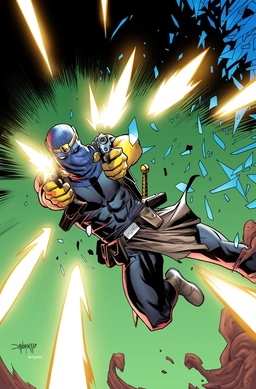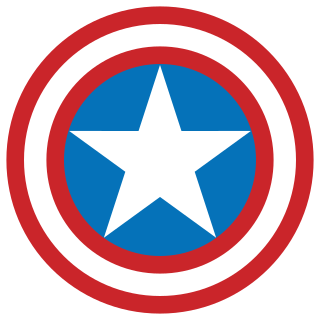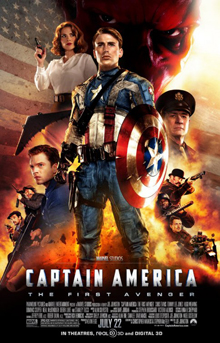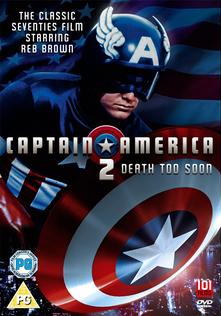
Captain America is a superhero created by Joe Simon and Jack Kirby who appears in American comic books published by Marvel Comics. The character first appeared in Captain America Comics #1, published on December 20, 1940, by Timely Comics, a corporate predecessor to Marvel. Captain America's civilian identity is Steve Rogers, a frail man enhanced to the peak of human physical perfection by an experimental "super-soldier serum" after joining the United States Army to aid the country's efforts in World War II. Equipped with an American flag-inspired costume and a virtually indestructible shield, Captain America and his sidekick Bucky Barnes clashed frequently with the villainous Red Skull and other members of the Axis powers. In the final days of the war, an accident left Captain America frozen in a state of suspended animation until he was revived in modern times. He resumes his exploits as a costumed hero and becomes leader of the superhero team the Avengers, but frequently struggles as a "man out of time" to adjust to the new era.

The Red Skull is a supervillain appearing in American comic books published by Marvel Comics and its predecessor Timely Comics. In Captain America Comics #1, the Red Skull's secret identity was revealed to be George Maxon; It would be retroactively established that he was merely a decoy who was working for the real Red Skull. Albert Malik would later adopt the Red Skull mantle, only to be killed in a plot orchestrated by the original.

The Falcon is a superhero appearing in American comic books published by Marvel Comics. The character was introduced by writer-editor Stan Lee and artist Gene Colan in Captain America #117, and was the first Black American superhero in mainstream comic books.

Captain America is a superhero appearing in books published by Marvel Comics. He appears in the Ultimate Marvel line of books, and is an alternative version of Captain America. The character first appeared in The Ultimates #1, and was created by writer Mark Millar and artist Bryan Hitch.

Sharon Carter is a character appearing in American comic books published by Marvel Comics. Created by Stan Lee, Jack Kirby, and Dick Ayers, the character first appeared in Tales of Suspense #75. Sharon Carter is a secret agent and an ex-field agent of S.H.I.E.L.D. under Nick Fury. She is also a love interest of the superhero Captain America / Steve Rogers. Sharon Carter was originally the younger sister of Peggy Carter. She was later retconned as Peggy's grand-niece because of the unaging nature of comic book characters.

Captain America's shield is a fictional item appearing in American comic books published by Marvel Comics. It is the primary defensive and offensive piece of equipment used by Captain America, and is intended to be an emblem of American culture.

Battlestar is a superhero appearing in American comic books published by Marvel Comics. Created by Mark Gruenwald and Paul Neary, the character made his first appearance in Captain America #323 (1986). He became the fifth character to assume the alias Bucky before taking on the name "Battlestar."

Betsy Ross is a character appearing in American comic books published by Marvel Comics. Created by Joe Simon and Jack Kirby, the character first appeared in Captain America Comics #1. Betsy Ross is Captain America's early love interest and supporting character in American comic books published by Marvel Comics during the 1930-1940s period known to historians and collectors as the Golden Age of Comic Books. She then debuted as the superheroine Golden Girl in Captain America Comics #66.

Helmut Zemo is a character appearing in American comic books published by Marvel Comics. Created by Roy Thomas, Tony Isabella and Sal Buscema, the character first appeared in Captain America #168. Helmut Zemo is the son of Baron Heinrich Zemo and the thirteenth Baron Zemo in his family lineage. He is a recurring adversary of the Avengers, especially the superhero Steve Rogers / Captain America. The character has also been known as Citizen V at various points in his history.

Captain America is a 1944 Republic black-and-white 15-chapter serial film loosely based on the Timely Comics character Captain America. It was the last Republic serial made about a superhero. It also has the distinction of being the most expensive serial that Republic ever made. It stands as the first theatrical release connected to a Marvel character; the next theatrical release featuring a Marvel hero would not occur for more than 40 years. It was the last live-action rendition of a Marvel character in any medium until Spider-Man appeared in the Spidey Super Stories segment of the children's television series The Electric Company in 1974.

Since the 1940s, the comic book character Captain America has been presented in a wide variety of other media, including serial films, feature films, animations, and video games.
Captain America is a superhero created by Joe Simon and Jack Kirby who appears in American comic books published by Marvel Comics.

Super-Patriot is a name used by three fictional characters in the universe of Marvel Comics. The first was an enemy of Nick Fury and S.H.I.E.L.D. The second was John Walker, who used the name Super-Patriot as a rival to Captain America. When Steve Rogers gave up the role of Captain America, Walker was tapped by the Commission on Superhuman Activities to replace Rogers; Walker later adopted the moniker U.S. Agent after Rogers' return. The third person to use the alias was Mike Farrell, a former neighbor of Steve Rogers, who became Super-Patriot and allied himself with Dead Ringer, a mutant villain with the power to mimic.

Captain America: Reborn is a six-issue monthly comic book limited series published by Marvel Comics between July 2009 and January 2010. The series was written by Ed Brubaker, illustrated by Bryan Hitch, and inked by Butch Guice. The series reveals the truth regarding the death of the original Captain America, Steve Rogers and revives him in the contemporary Marvel Universe.

Captain America: The First Avenger is a 2011 American superhero film based on the Marvel Comics character Captain America. Produced by Marvel Studios and distributed by Paramount Pictures, it is the fifth film in the Marvel Cinematic Universe (MCU). The film was directed by Joe Johnston, written by Christopher Markus and Stephen McFeely, and stars Chris Evans as Steve Rogers / Captain America alongside Tommy Lee Jones, Hugo Weaving, Hayley Atwell, Sebastian Stan, Dominic Cooper, Toby Jones, Neal McDonough, Derek Luke, and Stanley Tucci. During World War II, Steve Rogers, a frail man, is transformed into the super-soldier Captain America and must stop the Red Skull (Weaving) from using the Tesseract as an energy source for world domination.

Captain America II: Death Too Soon is a 1979 American made-for-television superhero film based on the Marvel Comics character Captain America, directed by Ivan Nagy and starring Reb Brown. The film was preceded by Captain America earlier the same year. It was aired on CBS in two one-hour slots. The first part aired on November 23, 1979, and the second aired the next night, leading into the conclusion of Salem's Lot.

Captain America, a superhero created by Joe Simon and Jack Kirby who appears in comic books produced by Marvel Comics, has appeared in multiple films since the character's inception in 1940. Republic Pictures released a fifteen-part Captain America serial film in 1944 that was the first film to feature a Marvel Comics character, though it deviated significantly from the comic book source material. Two made-for-TV films, Captain America and Captain America II: Death Too Soon, aired on the American broadcast television station CBS in 1979. A feature-length film directed by Albert Pyun was originally planned for a wide theatrical release in 1990, but received only a brief theatrical release in the United Kingdom before being released in the United States as a direct-to-video film.

James Buchanan "Bucky" Barnes is a character appearing in American comic books published by Marvel Comics. Originally introduced as a sidekick to Captain America, the character was created by Joe Simon and Jack Kirby and first appeared in Captain America Comics #1. Barnes' original costume and the Bucky nickname has been used by other heroes in the Marvel Universe over the years.

In fandom, Stucky is the pairing of Steve Rogers and James Buchanan "Bucky" Barnes, fictional characters who appear in comic books and related media produced by Marvel Comics. The pairing is a manifestation of shipping, a phenomenon in fandom wherein individuals create fan works that depict a romantic or sexual relationship between two characters whose relationship in the source material is typically neither romantic nor sexual; Stucky is an example of slash, a genre of fan works that focus on same-sex characters. In accordance with shipping naming conventions, Stucky is a portmanteau of "Steve" and "Bucky".

The Marvel Cinematic Universe (MCU) is an American media franchise and shared universe that involves productions of superhero films and television series. These productions star various titular superheroes; they are independently produced by Marvel Studios and are based on characters that appear in American comic books published by Marvel Comics. The shared universe, much like the original Marvel Universe in comic books, was established by crossing over common plots, settings, casts, and characters.


















